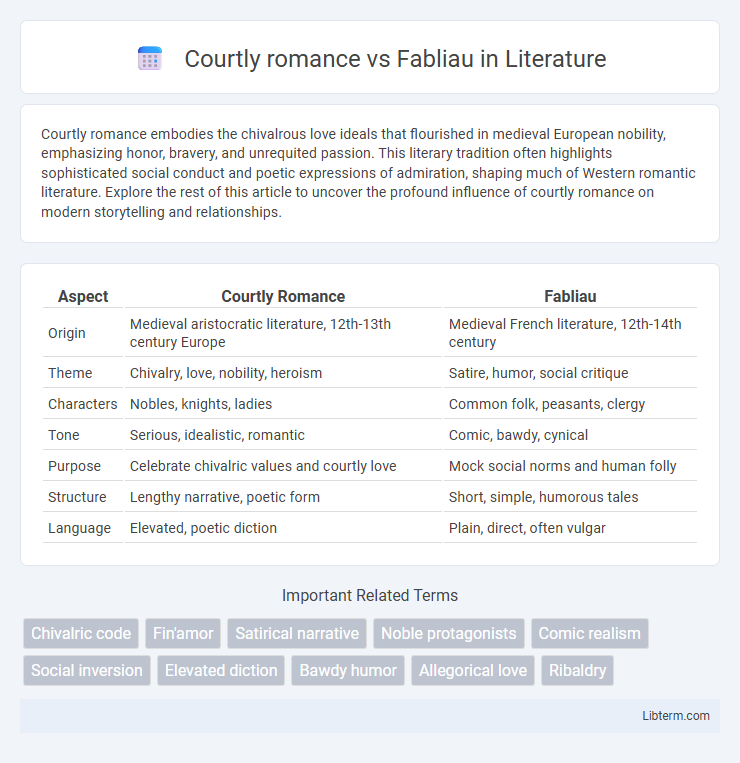Courtly romance embodies the chivalrous love ideals that flourished in medieval European nobility, emphasizing honor, bravery, and unrequited passion. This literary tradition often highlights sophisticated social conduct and poetic expressions of admiration, shaping much of Western romantic literature. Explore the rest of this article to uncover the profound influence of courtly romance on modern storytelling and relationships.
Table of Comparison
| Aspect | Courtly Romance | Fabliau |
|---|---|---|
| Origin | Medieval aristocratic literature, 12th-13th century Europe | Medieval French literature, 12th-14th century |
| Theme | Chivalry, love, nobility, heroism | Satire, humor, social critique |
| Characters | Nobles, knights, ladies | Common folk, peasants, clergy |
| Tone | Serious, idealistic, romantic | Comic, bawdy, cynical |
| Purpose | Celebrate chivalric values and courtly love | Mock social norms and human folly |
| Structure | Lengthy narrative, poetic form | Short, simple, humorous tales |
| Language | Elevated, poetic diction | Plain, direct, often vulgar |
Introduction to Courtly Romance and Fabliau
Courtly romance centers on noble characters and idealized love, often featuring chivalric quests and moral challenges that highlight virtues like honor and bravery. Fabliaux present short, comedic, and often bawdy tales focusing on clever trickery and social satire, typically involving lower-class characters and everyday situations. Both genres reflect medieval society's values but differ sharply in tone and thematic focus, with courtly romance elevating love and heroism while fabliaux emphasize humor and irony.
Historical Context and Origins
Courtly romance emerged in the medieval period, rooted in the chivalric ideals of the 12th and 13th centuries, reflecting the aristocratic culture of knights and noble courts primarily in France. Fabliaux originated around the same time but were grounded in the lower social classes, characterized by humorous, often bawdy tales that satirized the clergy and the bourgeoisie. Both genres provide valuable insights into the social hierarchies and cultural dynamics of medieval Europe, highlighting contrasting perspectives between noble idealism and popular skepticism.
Key Themes in Courtly Romance
Courtly romance centers on chivalry, idealized love, and noble quests, emphasizing honor, loyalty, and emotional refinement in medieval aristocratic settings. Themes often explore the tension between social duty and personal desire, with knights undertaking perilous adventures to prove their virtue and win the favor of a lady. The narrative typically idealizes relationships through secrecy, devotion, and spiritual love, contrasting sharply with the earthy humor and satirical tone found in fabliaux.
Central Motifs of Fabliau
Fabliaux center on bawdy humor, trickery, and satirical portrayals of social and clerical figures, contrasting sharply with the idealized love and chivalry found in courtly romance. Key motifs include deception, sexual cunning, and the subversion of authority, often emphasizing the cleverness of lower-class characters in outwitting nobility or clergy. These narratives explore human folly and hypocrisy through crude realism, providing a counterpoint to the moral and romantic ideals of courtly literature.
Social Class and Audience Differences
Courtly romance primarily targeted the medieval nobility, emphasizing themes of chivalry, honor, and noble quests that reflected upper-class ideals and values. Fabliaux, in contrast, catered to a broader audience including the emerging middle class, featuring satirical, often bawdy humor that mocked the clergy, peasants, and aristocracy alike. The differing social classes of their audiences influenced the content and tone, with courtly romance idealizing courtly love and aristocratic virtues, while fabliaux presented more earthy, comedic narratives accessible to common folk.
Narrative Structure and Style Comparison
Courtly romance features intricate narratives centered on noble quests, characterized by elevated language, detailed descriptions, and themes of chivalry and courtly love. Fabliaux present succinct, straightforward plots with earthy humor and satirical tones, employing colloquial language and focusing on lower-class characters and everyday situations. The narrative structure of courtly romance often includes episodic adventures and moral ideals, whereas fabliaux rely on rapid pacing and punchlines to deliver social critiques.
Attitudes Toward Love and Morality
Courtly romance idealizes love as noble, spiritual, and elevating, often portraying chivalric knights devoted to virtuous and unattainable ladies, emphasizing loyalty, honor, and moral purity. Fabliaux, conversely, adopt a cynical and humorous stance toward love and morality, depicting sexuality as earthy and pragmatic, frequently exposing human folly, hypocrisy, and moral corruption through satirical, bawdy narratives. This contrast highlights courtly romance's moral idealism versus fabliau's subversive critique of social and romantic conventions.
Gender Roles and Characterization
Courtly romance emphasizes idealized gender roles, portraying noble knights as chivalrous heroes and women as virtuous, often passive figures embodying beauty and moral purity. Fabliaux invert these norms by depicting characters with pragmatic, often subversive traits, where women are cunning and assertive, and male characters frequently exhibit folly or vice. This contrast highlights differing social commentaries: courtly romance promotes hierarchical virtue, while fabliaux critique social conventions through humor and satire.
Literary Significance and Cultural Impact
Courtly romance, characterized by ideals of chivalry and noble love, profoundly shaped medieval literature by promoting themes of honor, virtue, and courtly behavior, influencing the development of Western narrative traditions and inspiring later Romantic literature. Fabliau, contrasting with its humorous, satirical, and often bawdy portrayal of lower-class life, challenged social norms and offered a subversive critique of medieval society through its straightforward, comedic storytelling style. Together, these genres reveal the cultural dichotomy of medieval Europe, reflecting diverse societal values and contributing to a richer understanding of historical social dynamics and literary evolution.
Conclusion: Lasting Legacy and Contemporary Relevance
Courtly romance endures as a foundational influence on contemporary romantic narratives, emphasizing ideals of chivalry, honor, and noble love that continue to shape modern storytelling and cultural ideals. Fabliaux, with their bawdy humor and social satire, persist in inspiring comedic literature and media that challenge societal norms and expose human follies. Together, both genres contribute enduring narrative techniques and thematic complexity that enrich today's literary and popular culture landscapes.
Courtly romance Infographic

 libterm.com
libterm.com